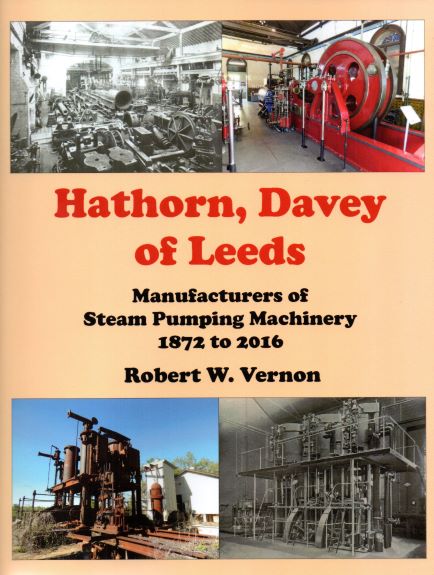
Hathorn, Davey of Leeds: Manufacturers of Steam Pumping Machinery. 1872 to 2016

Description
Rob Vernon, Sb, softback, 365pp 190 x 250
Hathorn, Davey of Leeds: Manufacturers of Steam Pumping Machinery. 1872 to 2016 is based on some 40 years of research by the author, it has taken him to Australia, Japan and South America. The company was established in 1872 as a means for a retired Scottish Army Captain, John Fletcher Hathorn, to give his half-brother a worthwhile career. A year later, a young engineer Henry Davey, joined the Partnership. Davey was to become probably one of the most innovative engineers in pumping technology of the period, and it was his patent of a new type of steam engine governor, the differential gear, together with its application to the two-cylinder Compound Engine, that gave the Company worldwide fame. The differential gear was fitted to many Cornish type beam engines as it eliminated potential piston damage if the load on the engine was suddenly removed by pump rod breakage, for example.
The Company was dominant during the period when the use of steam power was staring to wane. Nevertheless, the Compound Engine was sold to many colliery companies throughout the United Kingdom. The purchase of two engines by the South Staffordshire Mines Drainage Commission for example meant many less efficient pumping engines could be scrapped. Surviving hydraulic engines from this period can be seen underground in the Sir Francis Level, Swaledale, North Yorkshire and a steam pumping engine from the Marine Colliery, on the surface at Ebbw Vale, South Wales.
John Taylor and Sons held Hathorn, Davey pumping engines in high regard, for their efficiency and reliability and they erected Hathorn, Davey engines on their mines sites in Spain, India and Australia. The Vertical Compound engine at the Waihi Gold Mine, New Zealand with a 110 inches diameter low-pressure cylinder was the largest sold by the Company.
By 1900, the Company had come under the Directorship of the Lupton family, Leeds. At that time the triple expansion engine was popular mainly for waterworks, but some were also sold to a few mining companies. The last Compound Engine made by the Company was erected at the Mill Meece Pumping Station Staffordshire, and still works the original pair of pumping quadrants. In the Great Depression the Company got into financial difficulty and was rescued by Sulzer Brothers of Switzerland, who retained the name of Hathorn, Davey until 2016.
Rob's book describes the establishment of the Sun Foundry, Leeds where the Company was based, and the many partnerships in its formative years until the Company was finally wound up in 2016. The book is amply illustrated (170 drawings and photographs) together with examples of the many engines and pumps produced by the Company for mine sites worldwide. There are also contemporary descriptions of the engines taken from a variety of patents, and technical journals, and the book will more than satisfy those with an interest in mining and technology.
Hathorn, Davey of Leeds: Manufacturers of Steam Pumping Machinery. 1872 to 2016 is based on some 40 years of research by the author, it has taken him to Australia, Japan and South America. The company was established in 1872 as a means for a retired Scottish Army Captain, John Fletcher Hathorn, to give his half-brother a worthwhile career. A year later, a young engineer Henry Davey, joined the Partnership. Davey was to become probably one of the most innovative engineers in pumping technology of the period, and it was his patent of a new type of steam engine governor, the differential gear, together with its application to the two-cylinder Compound Engine, that gave the Company worldwide fame. The differential gear was fitted to many Cornish type beam engines as it eliminated potential piston damage if the load on the engine was suddenly removed by pump rod breakage, for example.
The Company was dominant during the period when the use of steam power was staring to wane. Nevertheless, the Compound Engine was sold to many colliery companies throughout the United Kingdom. The purchase of two engines by the South Staffordshire Mines Drainage Commission for example meant many less efficient pumping engines could be scrapped. Surviving hydraulic engines from this period can be seen underground in the Sir Francis Level, Swaledale, North Yorkshire and a steam pumping engine from the Marine Colliery, on the surface at Ebbw Vale, South Wales.
John Taylor and Sons held Hathorn, Davey pumping engines in high regard, for their efficiency and reliability and they erected Hathorn, Davey engines on their mines sites in Spain, India and Australia. The Vertical Compound engine at the Waihi Gold Mine, New Zealand with a 110 inches diameter low-pressure cylinder was the largest sold by the Company.
By 1900, the Company had come under the Directorship of the Lupton family, Leeds. At that time the triple expansion engine was popular mainly for waterworks, but some were also sold to a few mining companies. The last Compound Engine made by the Company was erected at the Mill Meece Pumping Station Staffordshire, and still works the original pair of pumping quadrants. In the Great Depression the Company got into financial difficulty and was rescued by Sulzer Brothers of Switzerland, who retained the name of Hathorn, Davey until 2016.
Rob's book describes the establishment of the Sun Foundry, Leeds where the Company was based, and the many partnerships in its formative years until the Company was finally wound up in 2016. The book is amply illustrated (170 drawings and photographs) together with examples of the many engines and pumps produced by the Company for mine sites worldwide. There are also contemporary descriptions of the engines taken from a variety of patents, and technical journals, and the book will more than satisfy those with an interest in mining and technology.





